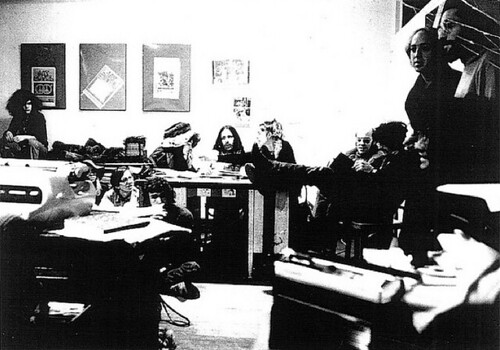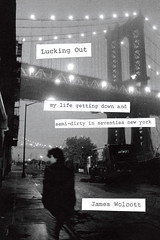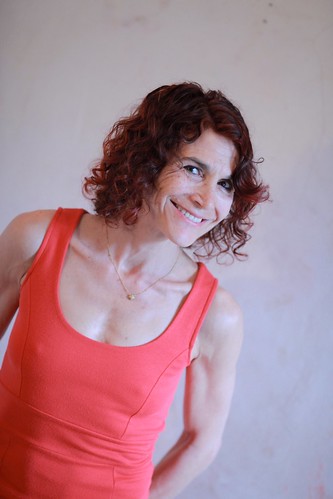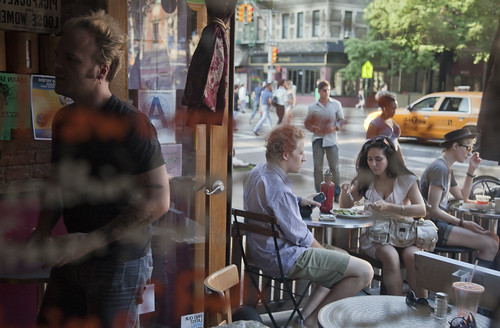 Left to right: Steven Kohn, (on floor:) Heather, R. Crumb, Ray Schultz, (sitting behind:) Hetty Maclise, John Heys, Coca Crystal, Allen Katzman, David Walley, Little Arthur, (standing:) Joel Fabrikant, Jaakov Kohn
Left to right: Steven Kohn, (on floor:) Heather, R. Crumb, Ray Schultz, (sitting behind:) Hetty Maclise, John Heys, Coca Crystal, Allen Katzman, David Walley, Little Arthur, (standing:) Joel Fabrikant, Jaakov KohnThe end of my real involvement with The East Village Other came as something I perceived as a betrayal. I have come to think I really didn’t understand it at the time and perhaps what happened wasn’t directed at me personally. But sometimes I wonder.
I mentioned in my earlier piece that EVO was formed as a stock company, with Walter Bowart, Allen Katzman and I each owning three shares.
“We need to raise more money,” Walter said to me in the spring of 1966. “We’ve run out. I’ve called a meeting and there will be new people coming. We need to get more people buying stock.”
“It won’t dilute my one third, will it?” I asked.
“It doesn’t have to,” he said, “if you buy some more, too.” And this was technically true.
The meeting took place in our office on Avenue A on a Tuesday evening at 8 p.m. John Wilcock was there, a prized defector to The Other from the Village Voice, our designated competitor. I loved that idea. There were four new people in the room, none of whom was familiar to me, except for John.
“Okay, we’re here to buy stock,” Walter said. “Who’d like to go first?” Read more…
 Fred W. McDarrah/Getty Images From left: Dan Rattiner, Walter Bowart, and brothers Allen and Don Katzman. Jan. 14, 1966.
Fred W. McDarrah/Getty Images From left: Dan Rattiner, Walter Bowart, and brothers Allen and Don Katzman. Jan. 14, 1966.Little is it known that Dan Rattiner, doyen of Dan’s Papers, helped launch the East Village Other alongside its more celebrated founders, the late Walter Bowart and the late Allen Katzman. In 1964, having abandoned graduate school in architecture at Harvard, Mr. Rattiner, in between gigs producing a summer newspaper in Montauk, rented an apartment in a brownstone on West 10th Street in Greenwich Village. A year later, in the fall of 1965, something amazed him on the newsstand at Eighth Street and Sixth Avenue. He picks up the story from there.
It cost 15 cents and was an enormous piece of newsprint all folded up into tabloid size. The four pages, when unfolded looked more like a work of modern art than a newspaper. A new way to print a newspaper was on the market. It involved using scissors and rubber cement to put together a proof of a page, then making a plate from a photograph of it and then printing from that. But I had never seen anyone make use of the new process like this before; most people just used it to mimic the old.
As for the content, it was also revolutionary. The lead headline read: “TO COMMEMORATE THE GLORIOUS NEWSPAPER STRIKE THE HERETOFORE UNDERGROUND ‘OTHER’ EXPANDS ITS PATAREALISM.” In huge black type, the words coiled along the perimeter of the page and ended with a half-tone photograph of a half-closed eye. “Peace Rally Breeds Strange Bedfellows,” was the headline below. “Generation of Draft Dodgers” read another headline below that.
I bought it. And I looked for, and found the name, address and phone number of the publisher and editor, Walter Bowart. Read more…
 Courtesy of Doubleday
Courtesy of Doubleday Luckily for East Villagers, James Wolcott’s memoir of his days as a young culture critic in a now nearly vanished city, “Lucking Out: My Life Getting Down and Semi-Dirty in Seventies New York,” places much of its meat and potatoes (along with plenty of gravy) right here in our very own backyard. Steering a middle course between the sometimes overly concentrated, every-word-counts prose of his Vanity Fair columns, and the more loosey-goosey style he deploys in his blog at the same publication, Mr. Wolcott reconfirms his position as New York’s wittiest critic.
Despite its pleasing portability (the book, out later this month, comes in at about 270 pages), “Lucking Out” covers plenty of ground, bopping from Mr. Wolcott’s mice-ridden “man-cave” on East 12th Street, down to CBGB, and back up to the Village Voice, where he made his name. It slides west for a gawk at the gay heyday of the West Village, then uptown for some quality time among the balletomanes of Lincoln Center (with a pause for skuzzy “Taxi Driver”-era Times Square porn along the way), and includes countless screening room séances with his mentor and muse, the late New Yorker film critic, Pauline Kael, to whom large portions of the book can be seen as an extended and touching valentine. Read more…
Joshua Davis Small businesses have had mixed reviews when it comes to Groupon, the online discount coupon provider. Atlas Cafe, 73 Second Avenue, uses Groupon as another way of advertising.
For a neighborhood with some of the highest concentrations of bars, restaurants and retail stores in New York, the East Village stands as a prime location for a coupon provider like Groupon.
“New York is a region that we continue to study intensively,” says Julie Mossler, a Groupon spokeswoman. “We handpick and curate the deals with the best businesses that are the most exciting or interesting in the area.”
But with questions being raised about Groupon’s business model, as well as complaints from some small business owners, The Local checked in with five East Village businesses to learn about their experiences with the coupon site.
While most business owners interviewed said that they saw an influx of customers, some voiced unhappiness with what they they saw as a lack of support by the site.
In response to situations in which a business owner was not completely satisfied with Groupon, Ms. Mossler said that Groupon attempts to work “extremely close” with merchants and describes their relationship as an “ongoing process.”
“It’s not like we sign you up, you run and that’s it,” she said. “You get an account representative who holds your hands through the process and gives you tools to help you take advantage of the feature.”
Read more…
 Michelle Rick
Michelle Rick Good morning, East Village.
When you think all the good ones are taken, try looking in your own backyard. That’s right East Villagers, our neighborhood ranks as the number one place for dating in New York City — or at least according to the online dating site, HowAboutWe. The Village Voice reported the findings earlier this week, noting that Webster Hall and the Strand top the list of local hotspots.
Of course there are other reasons for coming to the East Village, as we’ve seen each year with the so-called Crusties; but now it seems some of these annual squatters are not getting a warm welcome from the authorities, according to Andrea Stella, executive director of The Space at Tompkins.
But that’s not all that’s changing this summer. Jeremiah’s Vanishing New York shares photos from East Villager Andrea Legge, who lives in the building next to Mars Bar; both buildings will be bulldozed by the end of August.
 Paula CourtJody Oberfelder
Paula CourtJody OberfelderJody Oberfelder is an East Village dancer/choreographer who started out as the lead singer for the Bagdads, a punk band which played at CBGB’s. She then became a dancer and choreographer who has brought to both roles unusual athleticism, heart, humor, and in the words of Village Voice critic, Deborah Jowitt, “a zest for endearingly human dancing in an upside-down world.”
She has gone from creating works with titles such as “Wanted X Cheerleaders” and “Crash Helmet Brigade” to directing opera (“Dido and Aeneas”) and now Igor Stravinsky’s “The Soldier’s Tale,” which she will present at the Michael Schimmel Center for the Performing Arts at Pace University (where “Inside the Actors Studio” is filmed) from June 9 to 11. Recently The Local spoke to her about her work and how living in the East Village has influenced it.
Q.
You have been part of the East Village arts scene for a long time. How has living here informed your work as a dancer and choreographer?
A.
I’ve lived in the East Village from 1980 to the present, and I saw it change from a place where it was still full of old Ukrainian characters and really scary just to go east of Avenue A. When Life Café came into being on Avenue B, I remember kind of tip-toeing my way over there beside the park. I think I was just one of the many kinds of art-makers and filmmakers who was around at that time. Steve Buscemi and his wife Jo Andres were going to all the same events, and he’s pretty famous now! It was more of a cabaret-ish atmosphere, and you’d stay out pretty late, too. There was a great performance duo called Dancenoise, and also the “Full Moon” shows at P.S. 122. This was the more liquid East Village, more sweaty and physical. There were also people doing more esoteric work at the time.
Read more…
 Left to right: Steven Kohn, (on floor:) Heather, R. Crumb, Ray Schultz, (sitting behind:) Hetty Maclise, John Heys, Coca Crystal, Allen Katzman, David Walley, Little Arthur, (standing:) Joel Fabrikant, Jaakov Kohn
Left to right: Steven Kohn, (on floor:) Heather, R. Crumb, Ray Schultz, (sitting behind:) Hetty Maclise, John Heys, Coca Crystal, Allen Katzman, David Walley, Little Arthur, (standing:) Joel Fabrikant, Jaakov Kohn








